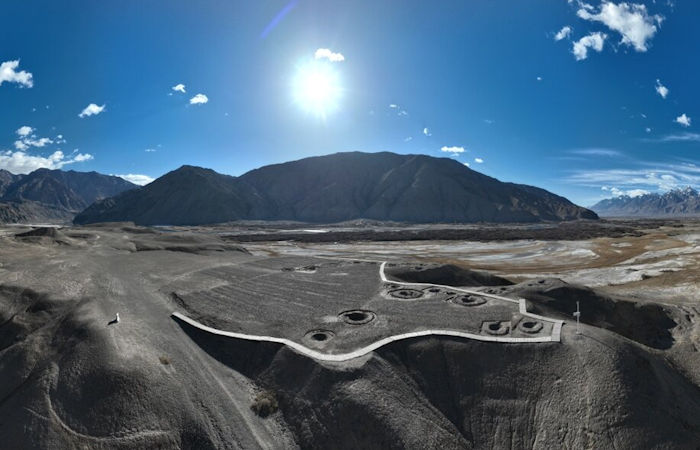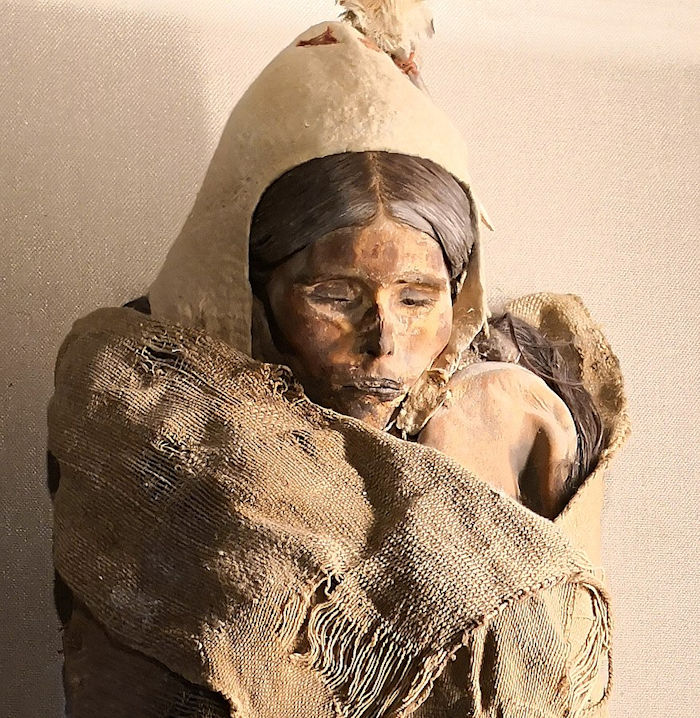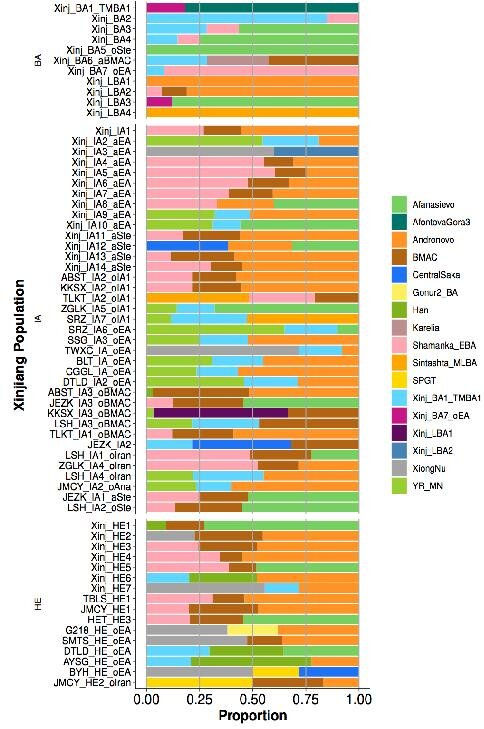Jan Bartek – AncientPages.com – The mysterious, light-skinned Tarim Basin mummies unearthed in China have long puzzled scientists. Who were these ancient people? Where did they come from? Why were they so different from the local population?
A new DNA analysis based on information from 201 ancient genomes from 39 archeological sites can shed new light on what took place in this region 5,000 years ago and tell more about the origin of the Tarim Basin people.

Overlook of Tombs in high alтιтudes. Excavated from Jierzankale site in Tashikuergan, Kashi region. Credit: Yan Xuguang, Kashi Daily
Xinjiang, in northwest China, is located at an important junction between east and west Eurasia and has played a historically important role in the exchange of goods and technologies between these two regions along the Silk Road. It is a complex mix of cultures and populations.
However, the interflow and blending of these diverse populations in Xinjiang can be traced further back. Bronze Age mummies discovered in Tarim Basin were purported to have western features and textiles, and the discovery of 5th century C.E. texts of an extinct Indo-European language group, Tocharian, has spurred great interest in archeologists, linguists, and anthropologists.
Now, a research team led by Prof. Fu Qiaomei from the Insтιтute of Vertebrate Paleontology and Paleoanthropology (IVPP) of the Chinese Academy of Sciences has unraveled the past population history of Xinjiang, China.
A Mix Of Local Northern Asian And Western Steppe Ancestry In The Bronze Age
The peopling of Bronze Age Xinjiang is key to understanding the later population dynamics of the region. It had been proposed that the Bronze Age settling of the Tarim Basin was originally by people related to either western Steppe Cultures (“Steppe hypothesis”) or Central Asian populations related to the Bactria Margiana Complex (BMAC) (“Bactrian oasis hypothesis”).
Fu and her team discovered the earliest inhabitants of Xinjiang showed genomic similarities with both of these groups, but broadly mixed with a unique ancestry found in the local Tarim Basin mummies, who were recently shown to be linked to a population found 25,000 years ago in southern Siberia known as the Ancient North Eurasians (ANE).

The Tarim Basin mummy known as the Beauty of Loulan. Credit: Wikimedia Commons – CC BY-SA 4.0
“In all, Bronze Age Xinjiang populations were found to contain ancestral components of the ‘local’ Tarim Basin population mixed to varying degrees with those of three groups from the surrounding regions: the Afanasievo, an Indo-European-ᴀssociated Steppe culture, a group called the Chemurchek, who contained BMAC ancestry from Central Asia, and ancestry from a Northeast Asian population called the Shamanka,” said Professor Fu, the last corresponding author of this paper.
The appearance of an individual with almost exclusive Northeast Asian ancestry in northern Xinjiang at this time indicated these early populations may have already been highly mobile. This evidence fits a scenario where incoming Steppe, Chemurchek and Northeast Asian populations entered the region and mixed with the existing inhabitants, who are closest to the oldest Tarim Basin mummies.
In the later part of the Bronze Age, they found the existing genomic profiles shifted to include an influx of a newer western Steppe group linked to the Steppe Middle-Late Bronze Age (MLBA) Andronovo culture, as well as an increasing influx of ancestry from East Asia found in southern Siberia. Furthermore, an expansion of ancestry related to Central Asia (BMAC) at this time indicated an increase in interactions with Central Asia across the Inner Asian Mountain Corridor.
Early Entry Of Indo-European Speakers In Bronze Age Xinjiang
Researchers also found ancestry of several Early Bronze Age individuals identified as unmixed Afanasievo ancestry.
This finding corroborates an early entry of these Indo-Europeans, who may have played a role in introducing Tocharian languages to Xinjiang, the easternmost Indo-European languages recorded. This early date would make the appearance of Indo-European languages in Xinjiang roughly contemporary with their entrance into Western Europe, clarifying the origin and spread of the language family with the largest number of speakers today.
Iron Age Influx Of East And Central Asians Established The Ancestry Still present Today
Compared to the Bronze Age, Iron Age populations showed an increased influx of people from East and Central Asia, with the presence of the East Asian component following a West-to-East gradient of increasing East Asian ancestry. Unlike the Northeast Asian ancestry present during the Bronze Age, the East Asian ancestry entering during the Iron Age showed more diverse origins including mainland East Asia.
These Iron Age populations could be linked to populations such as the Xiongnu and Han, which coincided with a historically documented westward expansion of Xiongnu in ~2200 BP after the defeat of Yuezhi in Gansu region. Additional Iron Age movements of people from Central Asia or the Indus periphery region into Xinjiang supported early activity along routes such as the Inner Asian Mountain Corridor.
The Iron Age appearance of ancestry linked to the Sakas, a nomadic confederation derived from the Iranian peoples, helps to date the entrance of Indo-Iranian languages like KH๏τanese, known to be spoken by the Sakas, into Xinjiang.
This Iron Age genetic profile of the region, linking Steppe, East Asian, and Central Asian people, was found to have been maintained into the Historical Era (HE). Despite the cultural shifts of the past millennia, similar ancestries to those established in the Iron Age are still observed in present day Xinjiang populations.

The qpAdm admixture proportions for all Xinjiang populations. Each bar represents admixture proportion of the listed subgroups for BA, LBA, IA and HE populations. Credit: Kumar et al. 2022, Science
Phenotypic analysis of several remains, the first reported for ancient Xinjiang, gave depth to the genetic results. The majority of individuals investigated had dark brown to black hair and brown eye color throughout Bronze Age, Iron Age, and HE. Corresponding with the appearance of Andronovo Steppe ancestry, a small proportion of the Iron Age individuals are marked by blond hair, blue eyes and lighter skin tone in the west and north of Xinjiang.
Two Early Bronze Age Tarim Basin mummies in east Xinjiang were found likely to have had dark brown to black hair and darker skin, despite their archeologically-identified “western” features, and a more recent third mummy from the Late Bronze Age was likely to have had a more intermediate skin tone.
“With the widespread population movements documented in the study, it is intriguing to see the degree of genetic continuity that has been maintained in Xinjiang over the past 5000 years.” said ᴀssociate Prof. Vikas Kumar from IVPP, the first author of this study.
See also: Mysterious White Chinese May Be Related To Ancient Roman Soldiers – Did Marcus Crᴀssus’ Army Settle Down In The Gobi Desert?
“What is striking about these results is that the demographic history of a cross-roads region as Xinjiang has been marked not by population replacements, but by the genetic incorporation of diverse incoming cultural groups into the existing population, making Xinjiang a true ‘melting-pot,'” said Professor Fu.
This detailed aspect had not been so clear looking only at archeological and cultural evidence. These findings suggest the importance of combining genetic and archeological evidence to provide a more comprehensive insight into population history.
See also: More Archaeology News
The current ancient DNA analysis highlights a holistic approach to unraveling the complex history of locations like Xinjiang, where the many interactions between different groups and cultures in the past make detailed demographic studies difficult. Future studies in this area could reveal more about the finer points of Xinjiang’s history.
The study was published in the journal Science.
Written by Jan Bartek – AncientPages.com Staff Writer





